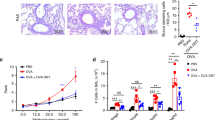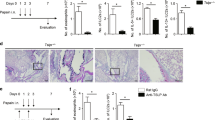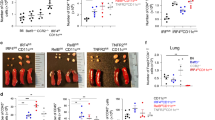Abstract
Using natural killer T (NKT) cell–deficient mice, we show here that allergen-induced airway hyperreactivity (AHR), a cardinal feature of asthma, does not develop in the absence of Vα14i NKT cells. The failure of NKT cell–deficient mice to develop AHR is not due to an inability of these mice to produce type 2 T-helper (Th2) responses because NKT cell–deficient mice that are immunized subcutaneously at non-mucosal sites produce normal Th2-biased responses. The failure to develop AHR can be reversed by the adoptive transfer of tetramer-purified NKT cells producing interleukin (IL)-4 and IL-13 to Ja281−/− mice, which lack the invariant T-cell receptor (TCR) of NKT cells, or by the administration to Cd1d−/− mice of recombinant IL-13, which directly affects airway smooth muscle cells. Thus, pulmonary Vα14i NKT cells crucially regulate the development of asthma and Th2-biased respiratory immunity against nominal exogenous antigens. Therapies that target Vα14i NKT cells may be clinically effective in limiting the development of AHR and asthma.
This is a preview of subscription content, access via your institution
Access options
Subscribe to this journal
Receive 12 print issues and online access
$209.00 per year
only $17.42 per issue
Buy this article
- Purchase on Springer Link
- Instant access to full article PDF
Prices may be subject to local taxes which are calculated during checkout





Similar content being viewed by others
References
Forecasted state-specific estimates of self-reported asthma prevalence—United States, 1998. Morb. Mortal. Wkly. Rep. 47, 1022–1025 (1998).
Wills-Karp, M. Immunologic basis of antigen-induced airway hyperresponsiveness. Annu. Rev. Immunol. 17, 255–281 (1999).
Martinez, F.D. et al. Asthma and wheezing in the first six years of life. N. Engl. J. Med. 332, 133–138 (1995).
Burrows, B., Martinez, F.D., Halonen, M., Barbee, R.A. & Cline, M.G. Association of asthma with serum IgE levels and skin-test reactivity to allergens. N. Engl. J. Med. 320, 271–277 (1989).
Illi, S. et al. The pattern of atopic sensitization is associated with the development of asthma in childhood. J. Allergy Clin. Immunol. 108, 709–714 (2001).
Van Eerdewegh, P. et al. Association of the ADAM33 gene with asthma and bronchial hyperresponsiveness. Nature 418, 426–430 (2002).
Holgate, S. et al. Epithelial-mesenchymal interactions in the pathogenesis of asthma. J. Allergy Clin. Immunol 105, 193–204 (2000).
Bendelac, A., Rivera, M.N., Park, S.H. & Roark, J.H. Mouse CD1-specific NK1 T cells: development, specificity, and function. Annu. Rev. Immunol. 15, 535–562 (1997).
Kronenberg, M. & Gapin, L. The unconventional lifestyle of NKT cells. Nat. Rev. Immunol. 2, 557–568 (2002).
Brossay, L. et al. CD1d-mediated recognition of an α-galactosylceramide by natural killer T cells is highly conserved through mammalian evolution. J. Exp. Med. 188, 1521–1528 (1998).
Kawano, T. et al. CD1d-restricted and TCR-mediated activation of Vα14 NKT cells by glycosylceramides. Science 278, 1626–1629 (1997).
Spada, F., Koezuka, Y. & Porcelli, S. CD1d-restricted recognition of synthetic glycolipid antigens by human natural killer T cells. J. Exp. Med. 188, 1529–1534 (1998).
Yoshimoto, T. & Paul, W.E. CD4+, NK1.1+ T cells promptly produce interleukin 4 in response to in vivo challenge with anti-CD3. J. Exp. Med. 179, 1285–1295 (1994).
Carnaud, C. et al. Cutting edge: Cross-talk between cells of the innate immune system: NKT cells rapidly activate NK cells. J. Immunol. 163, 4647–4650 (1999).
Cui, J. et al. Inhibition of T helper cell type 2 cell differentiation and immunoglobulin E response by ligand-activated Vα14 natural killer T cells. J. Exp. Med. 190, 783–792 (1999).
Wilson, S.B. et al. Extreme Th1 bias of invariant Vα24JαQ T cells in type 1 diabetes. Nature 391, 177–181 (1998).
Lee, P. et al. Testing the NKT cell hypothesis of human IDDM pathogenesis. J. Clin. Invest 110, 793–800 (2002).
Gombert, J. et al. Early quantitative and functional deficiency of NK1+-like thymocytes in the NOD mouse. Eur J. Immunol 26, 2989–2989 (1996).
Baxter, A., Kinder, S., Hammond, K., Scollay, R. & Godfrey, D. Association between αβTCR+CD4−CD8− T-cell deficiency and IDDM in NOD/Lt mice. Diabetes 46, 572–582 (1997).
Hammond, K. et al. α/β-T cell receptor (TCR)+CD4−CD8− (NKT) thymocytes prevent insulin-dependent diabetes mellitus in nonobese diabetic (NOD)/Lt mice by the influence of interleukin (IL)-4 and/or IL-10. J. Exp. Med. 187, 1047–1056 (1998).
Lehuen, A. et al. Overexpression of natural killer T cells protects Vα14-Jα281 transgenic nonobese diabetic mice against diabetes. J. Exp. Med. 188, 1831–1839 (1998).
Miyamoto, K., Miyake, S. & Yamamura, T. A synthetic glycolipid prevents autoimmune encephalomyelitis by inducing TH2 bias of natural killer T cells. Nature 413, 531–534 (2001).
Korsgren, M. et al. Natural killer cells determine development of allergen-induced eosinophilic airway inflammation in mice. J. Exp. Med. 189, 553–62 (1999).
Zhang, Y., Rogers, K.H. & Lewis, D.B. β2-microglobulin-dependent T cells are dispensable for allergen-induced T helper 2 responses. J. Exp. Med. 184, 1507–1512 (1996).
Brown, D. et al. β2-microglobulin-dependent NK1.1+ T cells are not essential for T helper cell 2 immune responses. J. Exp. Med. 184, 1295–304 (1996).
Smiley, S.T., Kaplan, M.H. & Grusby, M.J. Immunoglobulin E production in the absence of interleukin-4-secreting CD1-dependent cells. Science 275, 977–979 (1997).
Wills-Karp, M. et al. Interleukin-13: central mediator of allergic asthma. Science 282, 2258–2261 (1998).
Walter, D. et al. Critical role for IL-13 in the development of allergen-induced airway hyperreactivity. J. Immunol. 167, 4668–4675 (2001).
Corry, D.B. et al. Interleukin 4, but not interleukin 5 or eosinophils, is required in a murine model of acute airway hyperreactivity. J. Exp. Med. 183, 109–117 (1996).
Leckie, M. et al. Effects of an interleukin-5 blocking monoclonal antibody on eosinophils, airway hyper-responsiveness, and the late asthmatic response. Lancet 356, 2144–2148 (2000).
Nieuwenhuis, E.E. et al. CD1d-dependent macrophage-mediated clearance of Pseudomonas aeruginosa from lung. Nat. Med. 8, 588–593 (2002).
Matsuda, J. et al. Homeostasis of Vα14i NKT cells. Nat. Immunol. 3, 966–974 (2002).
Wang, B., Geng, Y. & Wang, C. CD1-restricted NK T cells protect nonobese diabetic mice from developing diabetes. J. Exp. Med. 194, 313–320 (2001).
Hong, S. et al. The natural killer T-cell ligand α-galactosylceramide prevents autoimmune diabetes in non-obese diabetic mice. Nat. Med. 7, 1052–1056 (2001).
Sharif, S. et al. Activation of natural killer T cells by α-galactosylceramide treatment prevents the onset and recurrence of autoimmune Type 1 diabetes. Nat. Med. 7, 1057–1062 (2001).
Cui, J. et al. Requirement for Vα14 NKT cells in IL-12–mediated rejection of tumors. Science 278, 1623–1626 (1997).
Leishman, A. et al. Precursors of functional MHC class I– or class II–restricted CD8αα+ T cells are positively selected in the thymus by agonist self-peptides. Immunity 16, 355–364 (2002).
Terabe, M. et al. NKT cell-mediated repression of tumor immunosurveillance by IL-13 and the IL-4R–STAT6 pathway. Nat. Immunol. 1, 515–520 (2000).
Heller, F., Fuss, I., Nieuwenhuis, E., Blumberg, R. & Strober, W. Oxazolone colitis, a Th2 colitis model resembling ulcerative colitis, is mediated by IL-13-producing NK-T cells. Immunity 17, 629–638 (2002).
McKenzie, G.J., Fallon, P.G., Emson, C.L., Grencis, R.K. & McKenzie, A.N. Simultaneous disruption of interleukin (IL)-4 and IL-13 defines individual roles in T helper cell type 2–mediated responses. J. Exp. Med. 189, 1565–1572 (1999).
Hansen, G., Berry, G., DeKruyff, R.H. & Umetsu, D.T. Allergen-specific Th1 cells fail to counterbalance Th2 cell–induced airway hyperreactivity but cause severe airway inflammation. J. Clin. Invest. 103, 175–183 (1999).
Matsuda, J. et al. Tracking the response of natural killer T cells to a glycolipid antigen using CD1d tetramers. J. Exp. Med. 192, 741–754 (2000).
Haczku, A. et al. Aspergillus fumigatus-induced allergic airway inflammation alters surfactant homeostasis and lung function in BALB/c mice. Am J. Respir. Cell. Mol. Biol. 25, 45–50 (2001).
Martin, T.R., Gerard, N.P., Galli, S.J. & Drazen, J.M. Pulmonary responses to bronchoconstrictor agonists in the mouse. J. Appl. Physiol. 64, 2318–2323 (1988).
Assenmacher, M., Schmitz, J. & Radbruch, A. Flow cytometric determination of cytokines in activated murine T helper lymphocytes: expression of interleukin-10 in interferon-γ and in interleukin-4-expressing cells. Eur. J. Immunol. 24, 1097–1101 (1994).
Sander, B., Cardell, S. & Möller, E. Interleukin 4 and interferon γ production in restimulated CD4+ and CD8+ cells indicates memory type responsiveness. Scand. J. Immunol. 33, 287–296 (1991).
Acknowledgements
We thank R. Blumberg for discussions, A. McKenzie for reagents, V.P. Yeung for technical support, and J. Faul, S. Galli and M. Tsai for help with the invasive measurement of AHR. These studies were supported by National Institutes of Health Public Health Service Grants RO1 AI26322 (D.T.U.), RO1 HL62348 (D.T.U.), RO1 CA52511 (M.K), AI40171 (M.J.G) and GM62135 (M.J.G); a grant from the American Lung Association of California (O.A.); fellowship STO 467/2-1 from the Deutsche Forschungsgemeinschaft (P.S.); and training grant T32AI07290 (E.M.).
Author information
Authors and Affiliations
Corresponding author
Ethics declarations
Competing interests
The authors declare no competing financial interests.
Supplementary information
Rights and permissions
About this article
Cite this article
Akbari, O., Stock, P., Meyer, E. et al. Essential role of NKT cells producing IL-4 and IL-13 in the development of allergen-induced airway hyperreactivity. Nat Med 9, 582–588 (2003). https://doi.org/10.1038/nm851
Received:
Accepted:
Published:
Issue Date:
DOI: https://doi.org/10.1038/nm851
This article is cited by
-
Invariant natural killer T cells in lung diseases
Experimental & Molecular Medicine (2023)
-
Progranulin regulates the development and function of NKT2 cells through EZH2 and PLZF
Cell Death & Differentiation (2022)
-
Association between the sinus microbiota with eosinophilic inflammation and prognosis in chronic rhinosinusitis with nasal polyps
Experimental & Molecular Medicine (2020)
-
DR3 stimulation of adipose resident ILC2s ameliorates type 2 diabetes mellitus
Nature Communications (2020)
-
TRAF3IP3 at the trans-Golgi network regulates NKT2 maturation via the MEK/ERK signaling pathway
Cellular & Molecular Immunology (2020)



